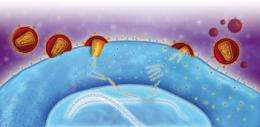Enlisting the AIDS virus to fight cancer

(Medical Xpress)—Can HIV be transformed into a biotechnological tool for improving human health? According to a CNRS team at the Architecture et Réactivité de l'ARN (RNA Architecture and Reactivity) laboratory, the answer is yes. Taking advantage of the HIV replication machinery, the researchers have been able to select a specific mutant protein. Added to a culture of tumor cells in combination with an anticancer drug, this protein improves the effectiveness of the treatment at 1/300 the normal dosage levels. Published in PLoS Genetics on 23 August 2012, these findings could lead to long-term therapeutic applications in the treatment of cancer and other pathologies.
The human immunodeficiency virus (HIV), which causes AIDS, uses human cell material to multiply, primarily by inserting its genetic material into the host cells' genome (see illustration below). The distinctive characteristic of HIV is that it mutates constantly, and consequently generates several mutant proteins (or variants) in the course of its successive multiplications. This phenomenon allows the virus to adapt to repeated environmental changes and resist the antiviral treatments that have been developed so far.
At the IBMC (Institut de Biologie Moléculaire et Cellulaire) in Strasbourg, the researchers of the CNRS Architecture et Réactivité de l'ARN laboratory had the idea of using this multiplication strategy to rechannel the effects of the virus for therapeutic purposes, in particular the treatment of cancer.
They first altered the HIV genome by introducing a human gene that is found in all cells: the gene for deoxycytidine kinase (dCK), a protein that activates anticancer drugs. Researchers have been trying to produce a more effective form of dCK for several years. Through HIV multiplication, the CNRS team has selected a "library" of nearly 80 mutant proteins and tested them on tumor cells in the presence of an anticancer drug. The results have enabled them to identify a dCK variant that is more effective than the wild-type (non-mutated) protein, inducing the death of tumor cells in culture. In combination with this protein, the anticancer drugs showed identical effectiveness at 1/300 the dose. The possibility of reducing the doses of anticancer drugs would palliate the problems posed by their components' toxicity, reduce their side effects and, most importantly, improve their effectiveness.
One advantage of this experimental technique is that the mutant proteins were tested directly on cells in culture. The next step in the years to come will be preclinical (animal) studies on the isolated mutant protein. In addition, this experimental system using a normally life-threatening virus is likely to lead to a great many other therapeutic applications.
More information: Retrovolution: HIV-driven Evolution of Cellular Genes and Improvement of Anticancer Drug Activation, Rossolillo P., Winter F., Simon-Loriere E., Gallois-Montbrun S. and Negroni M. PLoS Genetics, 23 August 2012.
















